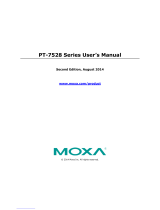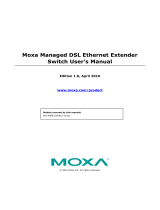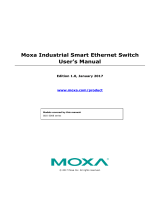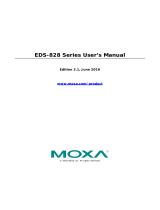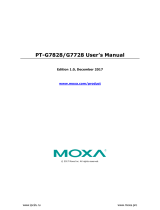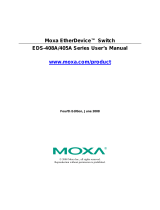Page is loading ...

Moxa EtherDevice™ Switch
EDS-510A Series User’s Manual
The software described in this manual is furnished under a license agreement and may be used only in
accordance with the terms of that agreement.
Copyright Notice
Copyright 2010 Moxa Inc.
All rights reserved.
Reproduction without permission is prohibited.
Trademarks
MOXA is a registered trademark of Moxa Inc.
All other trademarks or registered marks in this manual belong to their respective manufacturers.
Disclaimer
Information in this document is subject to change without notice and does not represent a commitment on the
part of Moxa.
Moxa provides this document “as is,” without warranty of any kind, either expressed or implied, including, but
not limited to, its particular purpose. Moxa reserves the right to make improvements and/or changes to this
manual, or to the products and/or the programs described in this manual, at any time.
Information provided in this manual is intended to be accurate and reliable. However, Moxa assumes no
responsibility for its use, or for any infringements on the rights of third parties that may result from its use.
This product might include unintentional technical or typographical errors. Changes are periodically made to the
information herein to correct such errors, and these changes are incorporated into new editions of the
publication.
Technical Support Contact Information
www.moxa.com/support
Moxa Americas:
Toll-free: 1-888-669-2872
Tel: +1-714-528-6777
Fax: +1-714-528-6778
Moxa China (Shanghai office)
:
Toll-free: 800-820-5036
Tel: +86-21-5258-9955
Fax: +86-10-6872-3958
Moxa Europe
:
Tel: +49-89-3 70 03 99-0
Fax: +49-89-3 70 03 99-99
Moxa Asia-Pacific
:
Tel: +886-2-8919-1230
Fax: +886-2-8919-1231

Table of Contents
Chapter 1 Introduction ...............................................................................................1-1
Overview.............................................................................................................................. 1-2
Package Checklist................................................................................................................. 1-2
Features ................................................................................................................................ 1-2
Industrial Networking Capability.............................................................................. 1-2
Designed for Industrial Applications......................................................................... 1-3
Useful Utility and Remote Configuration ................................................................. 1-3
Recommended Software and Accessories................................................................. 1-3
Chapter 2 Getting Started ..........................................................................................2-1
RS-232 Console Configuration (115200, None, 8, 1, VT100) ............................................. 2-2
Configuration using a Telnet Console .................................................................................. 2-5
Configuration using a Web Browser..................................................................................... 2-6
Disabling Telnet and Browser Access .................................................................................. 2-8
Chapter 3 Featured Functions...................................................................................3-1
Configuring Basic Settings................................................................................................... 3-2
System Identification................................................................................................. 3-2
Password ................................................................................................................... 3-3
Accessible IP............................................................................................................. 3-4
Port............................................................................................................................ 3-5
Network..................................................................................................................... 3-7
Time.......................................................................................................................... 3-9
Turbo Ring DIP Switch........................................................................................... 3-14
System File Update—By Remote TFTP................................................................. 3-17
System File Update—By Local Import/Export....................................................... 3-18
System File Update—By Backup Media ................................................................ 3-18
Restart ..................................................................................................................... 3-19
Factory Default........................................................................................................ 3-19
Using Port Trunking........................................................................................................... 3-20
The Port Trunking Concept..................................................................................... 3-20
Configuring Port Trunking...................................................................................... 3-21
Configuring SNMP............................................................................................................. 3-23
SNMP Read/Write Settings..................................................................................... 3-24
Trap Settings ........................................................................................................... 3-25
Private MIB information......................................................................................... 3-26
Using Communication Redundancy................................................................................... 3-26
Gigabit Ethernet Redundant Ring Capability (< 50 ms) ......................................... 3-27
The Turbo Ring Concept......................................................................................... 3-28
Configuring “Turbo Ring” and “Turbo Ring V2”................................................... 3-33
The Turbo Chain Concept....................................................................................... 3-38
Configuring “Turbo Chain”..................................................................................... 3-39
The STP/RSTP Concept.......................................................................................... 3-41
Configuring STP/RSTP........................................................................................... 3-47
Using Traffic Prioritization................................................................................................. 3-49
The Traffic Prioritization Concept.......................................................................... 3-50
Configuring Traffic Prioritization........................................................................... 3-52
Using Virtual LAN ............................................................................................................. 3-55
The Virtual LAN (VLAN) Concept........................................................................ 3-55

Sample Applications of VLANs using Moxa EDS-510A....................................... 3-58
Configuring Virtual LAN........................................................................................ 3-59
Using Multicast Filtering.................................................................................................... 3-62
The Concept of Multicast Filtering......................................................................... 3-62
Configuring IGMP Snooping.................................................................................. 3-65
Add Static Multicast MAC...................................................................................... 3-67
Configuring GMRP................................................................................................. 3-68
GMRP Table ........................................................................................................... 3-69
Using Bandwidth Management.......................................................................................... 3-69
Traffic Rate Limiting Settings................................................................................. 3-69
Using Port Access Control.................................................................................................. 3-70
Configuring Static Port Lock .................................................................................. 3-72
Configuring IEEE 802.1X....................................................................................... 3-72
Using Auto Warning........................................................................................................... 3-75
Configuring Email Warning.................................................................................... 3-76
Event Type.............................................................................................................. 3-76
Email Setup............................................................................................................. 3-78
Configuring Relay Warning.................................................................................... 3-79
Event Setup ............................................................................................................. 3-79
Warning List............................................................................................................ 3-80
Using Line-Swap-Fast-Recovery........................................................................................ 3-81
Configuring Line-Swap Fast Recovery................................................................... 3-81
Using Set Device IP............................................................................................................ 3-81
Configuring Set Device IP ...................................................................................... 3-83
Using Diagnosis.................................................................................................................. 3-86
Mirror Port .............................................................................................................. 3-86
Ping ......................................................................................................................... 3-87
Using Monitor .................................................................................................................... 3-89
Monitor by Switch................................................................................................... 3-89
Monitor by Port....................................................................................................... 3-90
Using the MAC Address Table........................................................................................... 3-90
Using Event Log................................................................................................................. 3-91
Using Syslog....................................................................................................................... 3-92
Using HTTPS/SSL ............................................................................................................. 3-93
Chapter 4 EDS Configurator GUI...............................................................................4-1
Starting EDS Configurator ................................................................................................... 4-2
Broadcast Search.................................................................................................................. 4-2
Search by IP address............................................................................................................. 4-3
Upgrade Firmware................................................................................................................ 4-4
Modify IP Address................................................................................................................ 4-5
Export Configuration............................................................................................................ 4-5
Import Configuration............................................................................................................ 4-7
Unlock Server....................................................................................................................... 4-8
Appendix A MIB Groups...............................................................................................A-1
Appendix B Modbus/TCP Map .....................................................................................B-1
EDS-510A Modbus information v1.0...................................................................................B-1

1
1
Chapter 1 Introduction
Welcome to the Moxa EDS-510A Series of EtherDevice Switches, the Gigabit Managed
Redundant Ethernet Switches designed specially for connecting Ethernet-enabled devices in
industrial field applications.
The following topics are covered in this chapter:
Overview
Package Checklist
Features

EDS-510A Series User’s Manual Introduction
1-2
Overview
As the world’s network and information technology becomes more mature, the trend is to use
Ethernet as the major communications interface in many industrial communications and
automation applications. In fact, a whole new industry has sprung up to provide Ethernet products
that comply with the requirements of demanding industrial applications.
The EDS-510A comes equipped with 3 gigabit Ethernet ports. Two of the ports can be used for
building a redundant Gigabit ring called Gigabit Turbo Ring, which gives system maintainers a
convenient means of setting up a versatile yet stable Gigabit Ethernet network. With Gigabit
Turbo Ring, if any segment of the network gets disconnected, your automation system will be
back to normal in under 300 ms. The third Gigabit Ethernet port can be a uplink port, which can
give 1000 Mbps link capability for transmitting all of the data to the control center. By providing
this third Gigabit Ethernet port, the EDS-510A can help the user build a complete Gigabit Ethernet
backbone network.
Package Checklist
The EDS-510A is shipped with the following items. If any of these items are missing or damaged,
please contact your customer service representative for assistance.
1 Moxa EtherDevice Switch EDS-510A
Hardware Installation Guide
CD-ROM with User’s Manual and Windows Utility
Moxa Product Warranty statement
RJ45 to DB9 console port cable
Protective caps for unused ports
DIN-Rail mounting kit (attached to the EDS-510A’s rear panel by default)
Features
Industrial Networking Capability
Turbo Ring, Turbo Chain (<20ms recovery time at full load) and STP/RSTP (IEEE 802.1w/D)
IPv6 ready (IPv6 Logo Committee certified)
IEEE 1588 PTP (Precision Time Protocol) for precise time synchronization of networks.
DHCP Option 82 for IP address assignment for different policies.
Supports Modbus/TCP
Supports LLDP (Link Layer Discovery Protocol)

EDS-510A Series User’s Manual Introduction
1-3
Designed for Industrial Applications
Bandwidth management prevents unpredictable network status
Support ABC-01 (Automatic Backup Configurator) for system configuration backup
Long-haul transmission distance of 40 km or 80 km (with optional mini-GBIC)
Redundant, dual 12 to 45 VDC power inputs
IP30, rugged high-strength metal case
DIN-Rail or panel mounting ability
Bandwidth management to prevent unpredictable network status
Lock port for allowing access to authorized MAC addresses only
Port mirroring for online debugging
Automatic warning by exception through email, relay output
Digital inputs to integrate a sensor and alarm with an IP network
Automatic recovery of connected device IP addresses
Line-swap fast recovery
Useful Utility and Remote Configuration
Configurable using a Web browser, Telnet/Serial console, or Windows utility
Send ping commands to identify network segment integrity
Recommended Software and Accessories
SFP-1GSXLC:
Small form factor pluggable transceiver with 1000BaseSX, LC, 0.5 km, 0 to 60°C
SFP-1GSXLC-T:
Small form factor pluggable transceiver with 1000BaseSX, LC, 0.5 km, -20 to 75°C
SFP-1GLXLC:
Small form factor pluggable transceiver with 1000BaseLX, LC, 10 km, 0 to 60°C
SFP-1GLXLC-T:
Small form factor pluggable transceiver with 1000BaseLX, LC, 10 km, -40 to 75°C
SFP-1GLHXLC:
Small form factor pluggable transceiver with 1000BaseLHX, LC, 40 km, 0 to 60°C
SFP-1GLHXLC-T:
Small form factor pluggable transceiver with 1000BaseLHX, LC, 40 km, -40 to 75°C
SFP-1GZXLC:
Small form factor pluggable transceiver with 1000BaseZX, 80 km, LC, 0 to 60°C
ABC-01: Automatic Backup Configurator via RS-232 console port, 0 to 60°C
DR-4524: 45W/2A DIN-Rail 24 VDC power supply with 85 to 264 VAC input
DR-75-24: 75W/3.2A DIN-Rail 24 VDC power supply with 85 to 264 VAC input
DR-120-24: 120W/5A DIN-Rail 24 VDC power supply with 88 to 132 VAC/176 to 264 VAC
input by switch
EDS-SNMP OPC Server Pro: CD with EDS-SNMP OPC Server software and manual
WK-46: Wall Mounting Kit

2
2
Chapter 2 Getting Started
This chapter explains how to access the EDS-510A for the first time. There are three ways to
access the switch: serial console, Telnet console, and web browser. The serial console connection
method, which requires using a short serial cable to connect the EDS-510A to a PC’s COM port,
can be used if you do not know the EDS-510A’s IP address. The Telnet console and web browser
connection methods can be used to access the EDS-510A over an Ethernet LAN, or over the
Internet.
The following topics are covered in this chapter:
RS-232 Console Configuration (115200, None, 8, 1, VT100)
Configuration using a Telnet Console
Configuration using a Web Browser
Disabling Telnet and Browser Access

EDS-510A Series User’s Manual Getting Started
2-2
RS-232 Console Configuration (115200, None, 8, 1, VT100)
NOTE
Connection Caution!
1. You cannot connect to the EDS-510A simultaneously by serial console and Telnet.
2. You can connect to the EDS-510A simultaneously by web browser and serial console, or by
web browser and Telnet.
However, we strongly suggest that you do NOT use more than one connection method at the
same time. Following this advice will allow you to maintain better control over the
configuration of your EDS-510A.
NOTE
We recommend using Moxa PComm Terminal Emulator, which can be downloaded free of
charge from Moxa’s website.
Before running PComm Terminal Emulator, use an RJ45 to DB9-F (or RJ45 to DB25-F) cable to
connect the EDS-510A’s RS-232 console port to your PC’s COM port (generally COM1 or COM2,
depending on how your system is set up).
After installing PComm Terminal Emulator, perform the following steps to access the RS-232
console utility.
1. From the Windows desktop, click Start Programs PCommLite2.5 Terminal
Emulator.
2. Select Open under Port Manager to open a new connection.

EDS-510A Series User’s Manual Getting Started
2-3
3. The Communication Parameter page of the Property window opens. Select the appropriate
COM port for Console Connection, 115200 for Baud Rate, 8 for Data Bits, None for Parity,
and 1 for Stop Bits.
4. Click the Terminal tab, and select VT100 for Terminal Type. Click OK to continue.
5. Type 1 to select ansi/VT100 terminal type, and then press Enter.

EDS-510A Series User’s Manual Getting Started
2-4
6. The Console login screen will appear. Press Enter to open the Account pop-up selector and
then select either admin or user. Use the keyboard’s down arrow to move the cursor to the
Password field, enter the Console Password (this is the same as the Web Browser password;
leave the Password field blank if a console password has not been set), and then press Enter.
7. The EDS-510A’s Main Menu will be displayed. (NOTE: To modify the appearance of the
PComm Terminal Emulator window, select Font… under the Edit menu, and then choose the
desired formatting options.)
8. After entering the Main Menu, use the following keys to move the cursor, and to select
options.
Key Function
Up/Down/Left/Right arrows, or Tab Move the onscreen cursor
Enter Display & select options
Space Toggle options
Esc Previous Menu

EDS-510A Series User’s Manual Getting Started
2-5
Configuration using a Telnet Console
You may use Telnet to access the EDS-510A’s console utility over a network. To be able to access
the EDS’s functions over the network (by Telnet or web browser) from a PC host that is connected
to the same LAN as the EDS-510A, you need to make sure that the PC host and the EDS-510A are
on the same logical subnet. To do this, check your PC host’s IP address and subnet mask. By
default, the EDS-510A’s IP address is 192.168.127.253 and the EDS-510A’s subnet mask is
255.255.255.0 (for a Class C network). If you do not change these values, and your PC host’s
subnet mask is 255.255.0.0, then its IP address must have the form 192.168.xxx.xxx. On the other
hand, if your PC host’s subnet mask is 255.255.255.0, then its IP address must have the form
192.168.127.xxx.
NOTE
To use the EDS-510A’s management and monitoring functions from a PC host connected to the
same LAN as the EDS-510A, you must make sure that the PC host and the EDS-510A are
connected to the same logical subnet.
NOTE
Before accessing the console utility via Telnet, first connect one of the EDS-510A’s RJ45
Ethernet ports to your Ethernet LAN, or directly to your PC’s Ethernet card (NIC). You can use
either a straight-through or cross-over Ethernet cable.
NOTE
The EDS-510A’s default IP address is 192.168.127.253.
Perform the following steps to access the console utility via Telnet.
1. Click Start Run, and then telnet to the EDS-510A’s IP address from the Windows Run
window. (You may also issue the telnet command from the MS-DOS prompt.)
2. Type 1 to choose ansi/vt100, and then press Enter.

EDS-510A Series User’s Manual Getting Started
2-6
3. The Console login screen will appear. Press Enter to open the Account pop-up selector and
then select either admin or user. Use the keyboard’s down arrow to move the cursor to the
Password field, enter the Console Password (this is the same as the Web Browser password;
leave the Password field blank if a console password has not been set), and then press Enter.
4. When the Main Menu of the EDS-510A’s console utility opens, click Terminal
preferences… from the menu at the top of the window.
5. When the Terminal Preferences window opens, make sure that the VT100 Arrows option is
selected.
NOTE
The Telnet Console looks and operates in precisely the same manner as the RS-232 Console.
Configuration using a Web Browser
The EDS-510A’s web browser interface provides a convenient way to modify the switch’s
configuration and access the built-in monitoring and network administration functions. The
recommended web browser is Microsoft Internet Explorer 5.5 or 6.0 with JVM (Java Virtual
Machine) installed.
NOTE
To use the EDS-510A’s management and monitoring functions from a PC host connected to the
same LAN as the EDS-510A, you must make sure that the PC host and the EDS-510A are on the
same logical subnet.
NOTE
If the EDS-510A is configured for other VLAN settings, you must make sure your PC host is on
the management VLAN.

EDS-510A Series User’s Manual Getting Started
2-7
NOTE
Before accessing the EDS-510A’s web browser interface, first connect one of the switch’s RJ45
Ethernet ports to your Ethernet LAN, or connect directly to your PC’s Ethernet card (NIC). You
can establish a connection using either a straight-through or cross-over Ethernet cable.
NOTE
The EDS-510A’s default IP is 192.168.127.253.
Perform the following steps to access the EDS-510A’s web browser interface.
1. Open Internet Explorer and type EDS-510A’s IP address in the Address field. Press Enter to
establish the connection.
2. The web login page will open. Select the login account (Admin or User) and enter the
Password (this is the same as the Console password), and then click Login to continue. Leave
the Password field blank if a password has not been set.
NOTE
By default, the EDS-510A’s password is not set (i.e., is blank).

EDS-510A Series User’s Manual Getting Started
2-8
You may need to wait a few moments for the web page to be downloaded to your computer. Use
the menu tree on the left side of the window to open the function pages to access each of the
switch’s functions.
Disabling Telnet and Browser Access
If you are connecting the EDS-510A to a public network, but do not intend to use its management
functions over the network, we suggest using the RS-232 console’s Basic Settings System Info
page to disable both Telnet Console and Web Configuration, as shown in the following figure.

3
3
Chapter 3 Featured Functions
In this chapter, we explain how to access the EDS-510A’s configuration options, perform
monitoring, and use administration functions. There are three ways to access these functions:
RS-232 console, Telnet console, and web browser. The serial console connection method, which
requires using a short serial cable to connect the EDS-510A to a PC’s COM port, can be used if
you do not know the EDS-510A’s IP address. The Telnet console and web browser connection
methods can be used to access the EDS-510A over an Ethernet LAN, or over the Internet.
The web console is the most user-friendly way to configure the EDS-510A. In this chapter, we use
the web console interface to introduce the functions. There are only a few differences between the
web console, serial console, and Telnet console.
The following topics are covered in this chapter:
Configuring Basic Settings
Using Port Trunking
Configuring SNMP
Using Communication Redundancy
Using Traffic Prioritization
Using Virtual LAN
Using Multicast Filtering
Using
Bandwidth Management
Using Port Access Control
Using Auto Warning
Usin
g Line-Swap-Fast-Recovery
Using Set Device IP
Using Diagnosis
Using Monitor
Using the MAC Address Table
Using Event Log
Using Syslog
Using HTTPS/SSL

EDS-510A Series User’s Manual Featured Functions
3-2
Configuring Basic Settings
The Basic Settings group includes the most commonly used settings required by administrators to
maintain and control EDS-510A.
System Identification
The system identification items are displayed at the top of the web page, and will be included in
alarm emails. Entering the system identification information makes it easier to identify the
different switches connected to your network.
Switch Name
Setting Description Factory Default
Max. 30
Characters
This option is useful for specifying the role or
application of different EDS-510A units.
E.g., Factory Switch 1.
Managed Redundant Switch
[Serial No. of this switch]
Switch Location
Setting Description Factory Default
Max. 80
Characters
To specify the location of different EDS-510A
units. E.g., production line 1.
Switch Location
Switch Description
Setting Description Factory Default
Max. 30
Characters
Use this to enter a more detailed description of
the EDS-510A unit.
None
Maintainer Contact Info
Setting Description Factory Default
Max. 30
Characters
To provide information about whom to contact
in order to resolve problems. Use this to enter
contact information of the person responsible
for maintaining this EDS-510A.
None

EDS-510A Series User’s Manual Featured Functions
3-3
Web Auto-logout (s)
Setting Description Factory Default
60 ~ 86400 (seconds)
Disable or extend the auto-logout time for the
web management console.
0 (disable)
Age time (s)
Setting Description Factory Default
15 ~ 3825 (seconds)
The length of time that a MAC address entry
can remain in the Moxa switch. When an
entry reaches its aging time, it “ages out” and
is purged from the switch, effectively
cancelling frame forwarding to that specific
port.
300
Password
The EDS-510A provides two levels of access privilege: admin privilege gives read/write access to
all EDS-510A configuration parameters, and user privilege provides read access only. You will be
able to view the configuration, but will not be able to make modifications.
ATTENTION
The EDS-510A’s default Password is not set (i.e., is blank). If a Password is already set, then
you will be required to type the Password when logging into the RS-232 console, Telnet console,
or web browser interface.
Account
Setting Description Factory Default
admin “admin” privilege allows the user to modify all
EDS-510A configurations.
user “user” privilege only allows viewing EDS-510A
configurations.
admin

EDS-510A Series User’s Manual Featured Functions
3-4
Password
Setting Description Factory Default
Old Password
(Max. 16 Characters)
Type current password when changing the
password
None
New Password
(Max. 16 Characters)
Type new password when changing the password None
Retype Password
(Max. 16 Characters)
If you type a new password in the Password field,
you will be required to retype the password in the
Retype new password field before updating the
new password.
None
Accessible IP
The EDS-510A uses an IP address-based filtering method to control access to the EDS-510A
units.
Accessible IP Settings allows you to add or remove “Legal” remote host IP addresses to prevent
unauthorized access. Access to the EDS-510A is controlled by IP address. If a host’s IP address is
in the accessible IP table, then the host will be allowed access to the EDS-510A. You can allow
one of the following cases by setting this parameter:
Only one host with the specified IP address can access the EDS-510A
E.g., enter “192.168.1.1/255.255.255.255” to allow access to just the IP address 192.168.1.1.
Any host on a specific subnetwork can access the EDS-510A
E.g., enter “192.168.1.0/255.255.255.0” to allow access to all IPs on the subnet defined by
this IP address/subnet mask combination.
Any host can access the EDS-510A
Disable this function by deselecting the Enable the accessible IP list option.

EDS-510A Series User’s Manual Featured Functions
3-5
The following table shows additional configuration examples:
Allowable Hosts Input format
Any host Disable
192.168.1.120 192.168.1.120 / 255.255.255.255
192.168.1.1 to 192.168.1.254 192.168.1.0 / 255.255.255.0
192.168.0.1 to 192.168.255.254 192.168.0.0 / 255.255.0.0
192.168.1.1 to 192.168.1.126 192.168.1.0 / 255.255.255.128
192.168.1.129 to 192.168.1.254 192.168.1.128 / 255.255.255.128
Port
Port settings are included to give the user control over Port Access, Port Transmission Speed,
Flow Control, and Port Type (MDI or MDIX). An explanation of each configuration item follows:
Enable
Setting Description Factory Default
checked Allows data transmission through the port.
unchecked Immediately shuts off port access.
enabled
ATTENTION
If a connected device or sub-network is wreaking havoc on the rest of the network, the Disable
option under Advanced Settings/Port gives the administrator a quick way to shut off access
through this port immediately.
/

